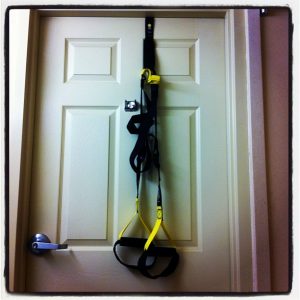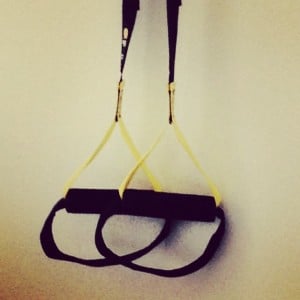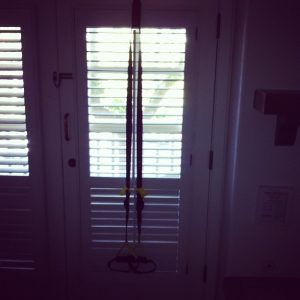TRX suspension trainer straps review and exercises
| filed under: Home Training, Travel Training, RNNR, Adaptive Training, TRX Suspension Training, Adaptive Exercise Solutions, Home Workout, Bodyweight Training, Fitness Equipment Reviews, Travel-Friendly Workouts, Suspension TrainingI love my TRX Suspension Trainer Straps. These days, I have it set permanently attached to my apartment's front door with the included door anchor. But only when I use it. It is amazingly portable and stuffs into the included webbed pouch.
I've taken it everywhere, be it in the bags of my motorcycle or in my TUMI roller of on my shoulder in a Filson bag. When it comes to training on the road, TRX straps travel much better than carrying weights or anything else with you.
Also, door-mounted exercises are limited but if you're brave, you can walk or run to a local school or park and hang it from a tree limb or jungle gym using the included suspension anchor.
I mostly use my TRX Home Suspension Trainer for assisted push-ups, assisted curls, assisted squats, chest presses, inverted rows, tricep-presses, chest fly, chest press, shrugs -- so many body weight exercises with such excellent possibilities for assistance.
The straps are really your friend.
It's been a while since I have looked over the TRX site. It looks like they have three levels of TRX trainers:
- TRX Go Gym Suspension Trainer at $129.95 (extra portable, light, foam grips)
- TRX Home Gym Suspension Trainer at $179.95 (which is what I have)
- TRX Pro Gym Suspension Trainer at $209.95 (nicer, hard-rubber grips)
- TRX Duo Suspension Trainer Trainer (commercial only, cool wooden grips)
If I were to do it again, I would probably just get the TRX Go as lighter is better and I am not a heavy-user or heavy abuser.
I might even get a TRX Go that is dedicated to travel and lives in my luggage instead of messing with the set I have set up permanently, and taped-down with duct tape, on the front door of my apartment.
That said, it's my fault that I am not a heavier-user.
Once the grips start getting chopped up and torn and so forth, I am sure that some electrical tape or duct tape might help for a while -- but I have had my TRX straps for years now and that's never been a problem.
I am not a heavy user and I don't so many exercises that require me to stuff my feet into the loops, so I don't know if certain exercises wear down the foam grips/handles differently than the exercises I do on them.
Here are 8 of the most common and awesome exercises that I do on my TRX, via Livestrong.




About TRX
TRX (Total Resistance Exercises) is a form of suspension training that leverages gravity and body weight to build strength, balance, flexibility, and core stability. Developed by former Navy SEAL Randy Hetrick in the late 1990s, TRX has grown into a globally recognized fitness system used by athletes, military personnel, and fitness enthusiasts alike. The TRX Suspension Trainer consists of adjustable straps with handles and foot cradles that allow users to perform a variety of exercises targeting different muscle groups.
About Suspension Trainers
Suspension trainers are exercise tools that use a system of straps, handles, and anchors to enable bodyweight training. They provide an effective way to engage multiple muscle groups simultaneously, improve stability, and enhance functional movement. Suspension trainers are widely used in gyms, physical therapy settings, and home workouts due to their versatility and ability to accommodate all fitness levels.
History of Suspension Trainers
The concept of suspension training dates back centuries, with gymnasts and martial artists historically using rings and ropes for strength training. However, modern suspension training gained prominence in the late 1990s when Randy Hetrick developed the TRX system using parachute webbing and a jiu-jitsu belt during his time in the Navy SEALs. The innovation allowed soldiers to maintain peak physical fitness in limited spaces, eventually leading to the commercial development of TRX and similar suspension training systems.
How Suspension Trainers Can Help Disabled People with Assistive Exercises
Suspension trainers are excellent tools for individuals with disabilities or limited mobility, offering scalable resistance and support for adaptive workouts. They can assist with:
-
Assisted squats and lunges: Providing stability for those with balance challenges.
-
Seated exercises: Allowing wheelchair users to perform upper body workouts.
-
Rehabilitation and physical therapy: Supporting recovery from injuries and muscle reactivation.
-
Core strengthening: Enabling safe engagement of core muscles with minimal joint strain.
Portability & Travel Friendliness
One of the standout features of suspension trainers is their portability. The TRX system, for example, is lightweight, compact, and easy to set up using a door anchor, tree branch, or sturdy beam. This makes it an ideal fitness solution for:
-
Frequent travelers
-
Small-space home workouts
-
Outdoor fitness enthusiasts
-
Athletes who need a mobile training system
FAQs
Q: Can beginners use suspension trainers?
A: Yes! Suspension training is highly adaptable, allowing users to modify exercises based on their fitness level. Adjusting body angle and strap length can make movements easier or more challenging.
Q: What makes TRX different from other suspension trainers?
A: TRX is one of the most recognized brands, known for high-quality materials, extensive exercise libraries, and professional certifications for trainers.
Q: Is suspension training safe for people with joint pain?
A: Yes, since many exercises are low-impact, they can reduce joint strain while strengthening supporting muscles.
Q: Can I use a TRX outside?
A: Absolutely! TRX straps can be anchored to a sturdy tree branch, playground equipment, or an outdoor fitness rig.
Glossary
Anchor Point: The fixed point where the suspension trainer is secured, such as a door frame or pull-up bar.
Body Angle: The angle at which a user positions their body to adjust exercise difficulty.
Eccentric Phase: The lowering phase of an exercise, which can be controlled for muscle strengthening.
Foot Cradles: The looped portion of the TRX straps designed to hold feet for exercises like planks and hamstring curls.
Instability Training: Exercises that challenge balance and stability to improve core and joint strength.
Progression: The act of increasing difficulty by altering grip, stance, or body positioning.
Regression: A modification that makes an exercise easier, such as stepping closer to the anchor point.

